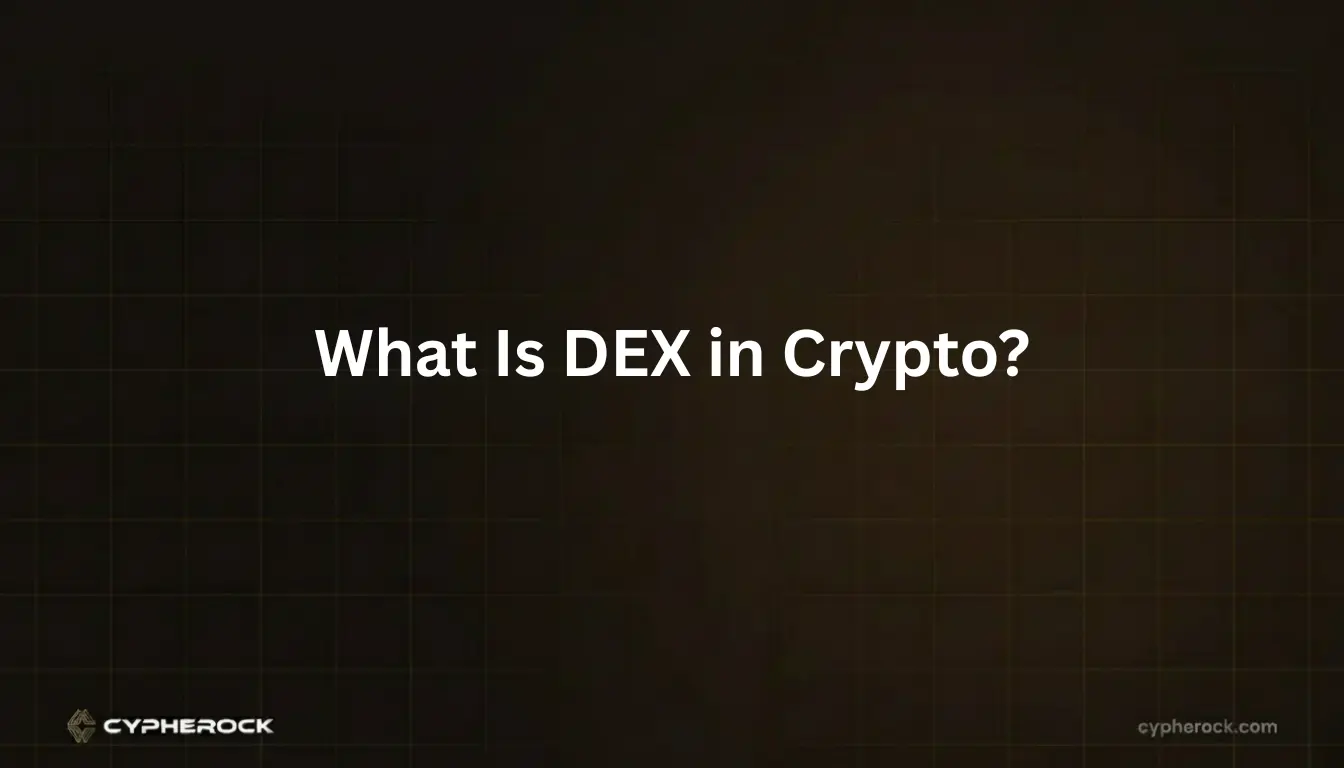

Centralized exchanges (CEXs) like Binance or Coinbase dominate the crypto trading landscape, but they come with a major drawback, they require you to hand over your funds. In other words, not your keys, not your crypto.
Over the years, this custody issue has led to massive losses through exchange hacks, withdrawal freezes, and even bankruptcies. Users began to realize the importance of self-custody and decentralization, leading to the rise of Decentralized Exchanges (DEXs).
But what is DEX in crypto, and how is it different from traditional platforms? A DEX offers a trustless trading environment where users retain full control of their assets and trade directly from their wallets without middlemen. It’s a critical part of the DeFi ecosystem, empowering financial independence and transparency.
At Cypherock, we believe that understanding decentralized tools like DEXs is the foundation of true crypto ownership. Let’s dive deeper to define DEX, learn what is DEX in crypto, and see how it works in practice.
To define DEX, the term stands for Decentralized Exchange. A DEX is a blockchain-based trading platform that enables peer-to-peer (P2P) crypto transactions without intermediaries like brokers or banks.
Instead of relying on a centralized authority to manage deposits and trades, a crypto DEX uses smart contracts , self-executing pieces of code that handle trading logic, liquidity, and settlements. This automation allows users to swap tokens directly from their personal wallets.
When people ask what is DEX in crypto, the answer lies in decentralization , control, transparency, and security. Unlike centralized exchanges, which hold user funds in custodial wallets, DEXs give traders full control over their assets. You keep your private keys and approve every transaction yourself.
Here’s a quick look at how they differ:
CEX (Centralized Exchange): Requires KYC verification, holds custody of your funds, and acts as the intermediary for trades.
DEX (Decentralized Exchange): Operates entirely on-chain using smart contracts, offers privacy, and gives users full custody of their crypto.
As of 2025, what is DEX in crypto has evolved from an experiment into an industry pillar. According to DeFiLlama, decentralized exchanges now process over $2 billion in daily trading volume. Platforms such as Uniswap, Curve, Balancer, and PancakeSwap have become the backbone of decentralized trading.
In short, when people search what is DEX in crypto, they’re looking for a platform that allows full financial independence, a place where you control your funds and trade directly on the blockchain.
To understand what is DEX in crypto, you need to see how these exchanges operate under the hood. The mechanics of a decentralized exchange rely on smart contracts, liquidity pools, and automated market-making systems that replace traditional order books.
At the heart of every crypto DEX are smart contracts , blockchain programs that define how swaps occur. Once deployed, they run autonomously and transparently, ensuring no third-party intervention. When you initiate a trade, your wallet interacts directly with these contracts, removing centralized control entirely.
Unlike centralized exchanges that depend on buyers and sellers, DEXs rely on liquidity pools. These pools contain pairs of tokens (e.g., ETH/USDC) supplied by liquidity providers (LPs) who earn a share of trading fees. Liquidity pools make trading continuous, ensuring that even smaller tokens always have a counterparty on-chain.
AMMs changed the meaning of what is DEX in crypto forever. Instead of matching individual orders, DEXs like Uniswap or PancakeSwap use mathematical formulas to determine token prices based on supply and demand within liquidity pools.
For example, when you trade ETH for USDC, the AMM smart contract calculates the price automatically and updates the pool balances accordingly.
So when you think what is DEX in crypto, it’s a platform powered by code, not custodians , smart contracts, liquidity pools, and AMMs working together to enable permissionless trading between users.
To fully grasp what is DEX in crypto, it’s useful to compare it with traditional centralized exchanges.
| Feature | Centralized Exchange (CEX) | Decentralized Exchange (DEX) |
| Custody | Exchange holds user funds | User retains private keys |
| KYC Requirement | Mandatory | Optional or none |
| Control | Centralized authority | Fully decentralized |
| Fees | Often higher | Lower, depends on network gas |
| Security | Single point of failure | Distributed, user-controlled |
| Transparency | Limited | Fully on-chain and verifiable |
In short, what is DEX in crypto can be summarized as the inverse of a CEX. A DEX provides transparency, control, and direct access to assets, while a CEX provides convenience but at the cost of custody.
DeFi users increasingly choose decentralized exchanges for their sovereignty and privacy, while casual traders may still rely on CEXs for liquidity and fiat on-ramps.
The benefits of what is DEX in crypto go beyond convenience , they represent a new model of financial freedom.
When you define DEX, it’s not just a platform, it’s a paradigm shift in ownership and control.
No discussion of what is DEX in crypto is complete without addressing the risks.
To reduce these risks, use hardware wallets like Cypherock X1 when interacting with DEXs. This ensures your private keys stay offline, safe from phishing, malware, or browser-based exploits, a key security measure for anyone learning what is DEX in crypto.
Let’s break down how to use a decentralized exchange safely and effectively.
Pro Tip: Using Cypherock X1 lets you interact with DEX smart contracts without ever exposing your private keys. Your transactions are signed within the device, not on your computer , a critical layer of defense for anyone exploring what is DEX in crypto safely.
The future of what is DEX in crypto lies in scalability and interoperability. DEXs are moving toward cross-chain bridges, Layer-2 scaling, and aggregators like 1inch that pool liquidity from multiple sources to deliver better prices.
As regulations tighten on centralized platforms, decentralized exchanges are emerging as the go-to solution for borderless trading. Analysts project that DEXs could account for over 25% of all crypto trading volume by 2025, solidifying their position as a core DeFi component.
The growth of DEXs symbolizes the shift from institutional custody to personal sovereignty , a world where your funds, data, and identity remain yours. That’s the real meaning behind what is DEX in crypto.
Q1: What is a DEX in crypto?
A DEX, or decentralized exchange, is a blockchain-based trading platform that allows peer-to-peer crypto swaps without intermediaries.
Q2: How does a DEX differ from a centralized exchange?
Unlike CEXs that hold your assets, DEXs let you trade directly from your wallet using smart contracts , the essence of what is DEX in crypto.
Q3: Are DEXs safe?
Yes, but only if used carefully. Smart contract vulnerabilities and fake sites pose risks. Always use Cypherock X1 to keep your private keys offline and secure.
Q4: Can I use a hardware wallet with DEXs?
Absolutely. Hardware wallets like Cypherock X1 are the best way to interact safely with decentralized exchanges.
Q5: Do DEXs charge fees?
Yes, most DEXs charge small fees for trades and liquidity provider rewards. However, fees are typically lower than centralized platforms.
Understanding what is DEX in crypto is key to navigating decentralized finance with confidence. DEXs give you self-custody, transparency, and the ability to trade without middlemen, empowering you to truly own your crypto.
While DEXs have inherent risks, secure tools like Cypherock X1 make them far safer by keeping your private keys offline and protected from online threats. As decentralized finance grows, mastering how DEXs work will become an essential skill for every investor.
When exploring decentralized exchanges, always prioritize security. Keep your private keys offline with Cypherock X1, the best cold wallet for safe and seamless DEX trading.

